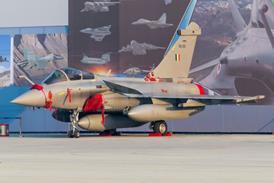The USA’s troubled Osprey tiltrotor is returning to combat duty, some 10 months after a deadly crash in Japan killed eight US Air Force (USAF) personnel.
The head of Air Force Special Operations Command (AFSOC), which operates 51 of the Bell-Boeing CV-22 Ospreys, says it will deploy an unspecified number of the tiltrotors to frontline service in the coming weeks – the first such instance since the fatal mishap in November 2023.
Lieutenant General Michael Conley revealed the milestone on 18 September at the annual Air & Spaces Forces Association (AFA) conference near Washington DC.
“As of right now, we’re [at] about 60% of the fleet that has returned to flying,” Conley says of the air force’s CV-22s. The fleet should reach 100% combat-ready status by the end of this year or early the next.

The three-star general, himself an Osprey pilot, says AFSOC went through a “deliberate, slow and methodical” process to inspect all of its Ospreys and retrain aviators. Now, the first of those re-certified aircraft and crews will be returning to combat duty – with the USAF the first operator to do so.
The move by the air force to send the V-22 back into frontline service seemingly contrasts with recent statements made by the head of Naval Air Systems Command (NAVAIR), which serves as the global airworthiness authority for the Osprey.
“We are methodically looking at material and non-material changes that we can make to allow for a full mission set without controls in place,” Admiral Carl Chebi told members of Congress in June. “Based on the data that I have today, I’m expecting that this will not occur until mid-2025.”
US Marine Corps MV-22s have been flying non-combat missions since at least April. The Pentagon lifted the original grounding order in March.
“Controls in place” appears to be the key factor enabling AFSOC’s decision. Those included remaining within 30 minutes flying time of a divert airfield, according to draft budget documents and testimony submitted by NAVAIR.
Conley says the Osprey’s speed in fixed-wing mode keeps it within acceptable travel time to an alternative airfield or ship on most flights, with the exception being long-distance sorties over open water.

Other flight procedures have also changed, including how pilots react to cockpit warnings of material failure. An investigation into the fatal crash found a catastrophic failure in the left-side prop-rotor gearbox produced metallic fragments that eventually brought down the rotorcraft.
The incident pilot in that case ignored multiple cockpit warning indicators triggered by onboard sensors meant to detect potentially dangerous metal chip fragments.
Conley says new procedures are now in place to minimise the risk of a repeat occurrence. These include a “land as soon as practical” directive for a single chip fragment warning and a “land as soon as possible” mandate in the event of a second warning.
Previous guidelines allowed for three warnings before those procedures were triggered.
Officials from both the navy and the air force say the gearbox issue that caused the Japan crash had never previously been observed anywhere in the Osprey fleet, which has seen multiple fatal crashes in recent years. The services say they are working with manufacturer Bell to develop a material solution to the problem.
“The data suggests it’s very rare,” Conley says. “I would not put the men and women of AFSOC back on the plane if I wasn’t confident that it could do what we need it to do.”
While he declines to specify where the AFSOC tiltrotors are being deployed, Conley did confirm their destination is not Europe or the Indo-Pacific – leaving the Middle East as the likely candidate.
The Pentagon maintains ongoing counter-terrorism missions in Iraq and Syria.
Another option could be Africa. However, the US military’s footprint on that continent has been substantially reduced in recent months, with the withdrawal of American forces from two key bases in Niger.
The USAF’s top officer for Europe and Africa – General James Hecker – confirmed on 17 September that his troops have completely pulled out from Air Base 101 and 201.
“We’re looking for other places in the western region of Africa where we could reposition some troops,” Hecker said at the AFA conference.
Those forces had been supporting counter-terrorism efforts in the Sahel region, before a military coup in Niamey reversed the local government’s support for the mission.






























